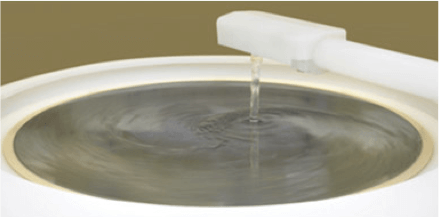This is part of a series of short interviews, based on face-to-face meetings at SEMICON West 2013.
SSEC had a lot to celebrate at this year’s SEMICON West, 2013. The company launched two new equipment platforms, WaferStorm and WaferEtch, each configuring single wet wafer processes for specific applications. Two of the tools launched on these platforms apply directly to the 3D IC market, the TSV CLEANER and TSV REVEALER.
According to the company, SSEC’s WaferStorm TSV CLEANER is proven to remove residues in high-aspect-ratio holes that wet bench-only or spray-only tools leave behind. The tool features SSEC’s unique equal-time soak software for process control combined with a traditional spray technology chamber
WaferEtch’s flagship tool is the TSV REVEALER, specifically configured to address the requirements of TSV reveal, which is the process where the backside of the wafer is thinned to reveal the copper interconnects. It has become a target area in the manufacture of 2.5D and 3D IC packaging for process control and cost reduction.
I’d recently discussed the SSEC’s TSV reveal process with Laura Mauer, CTO SSEC, at ECTC 2013 in May. At SEMICON West, in addition to the tool launch, she also had some updates on chemistry development for the TSV reveal process.
Environmental and personal safety is high on the list for best practices in semiconductor manufacturing. This is one reason wet etch for TSV reveal hasn’t taken off yet, even though its known to be a lower cost alternative to DRIE processes. The chemistry of record for wet etch is TMAH, which is known to be caustic, and can cross the skin barrier on contact.
“Many companies have restrictions on the concentration of TMAH in process chemistries, and some have banned it altogether,” said Mauer. “We were able to achieve favorable etch rates with KOH, which has no health concerns.”
However, KOH leaves a potassium silicate residue that needs to be cleaned, so SSEC set out to further optimize its process chemistries to address this. Mauer says they have been working with SACHEM Chemical Company to develop a proprietary material, SACHEM Developmental Silicon Etchant SMC42-1, an aqueous chemistry that does not contain potassium, and therefore is residue free. This chemistry has demonstrated a high etch rate “right where we need it to be” said Mauer. Furthermore, it offers additional cost savings because the need for the clean step is eliminated. From a Capex perspective, that means more chambers can be dedicated to etch processes ,which translates to increased throughput. With the adoption of this new chemistry, Mauer says SSEC will begin to phase out the use of KOH.
SACHEM’s developmental reveal etch chemistry combines its core capability in formulation with a deep knowledge of silicon etching, explained Kevin McLaughlin, PhD., Global Electronic Materials Marketing Manager SACHEM, Inc. He says SSEC and SACHEM worked closely to create a formulation that optimizes etch rate and surface roughness, creating a process that meets both technical and integration requirements. “By eliminating metals and TMAH from the reveal etch formulation while maintaining the high performance these chemistries provide, we’ve taken a significant step forward in enabling the TSV process,” says McLaughlin. ~ F.v.T.


















